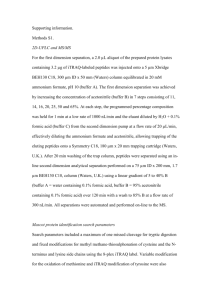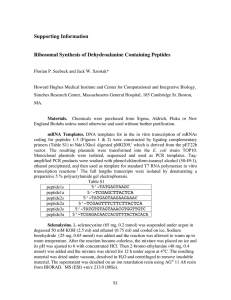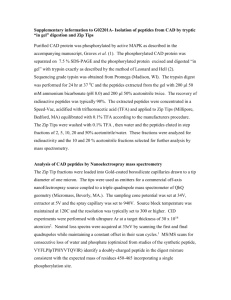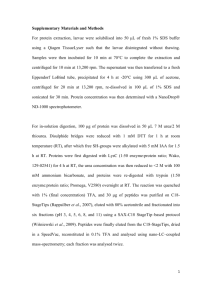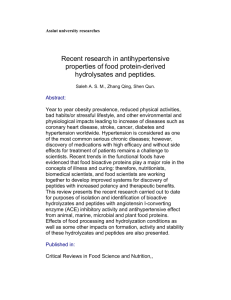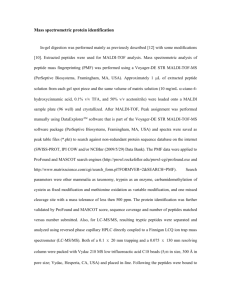13474 - Cell Signaling Technology
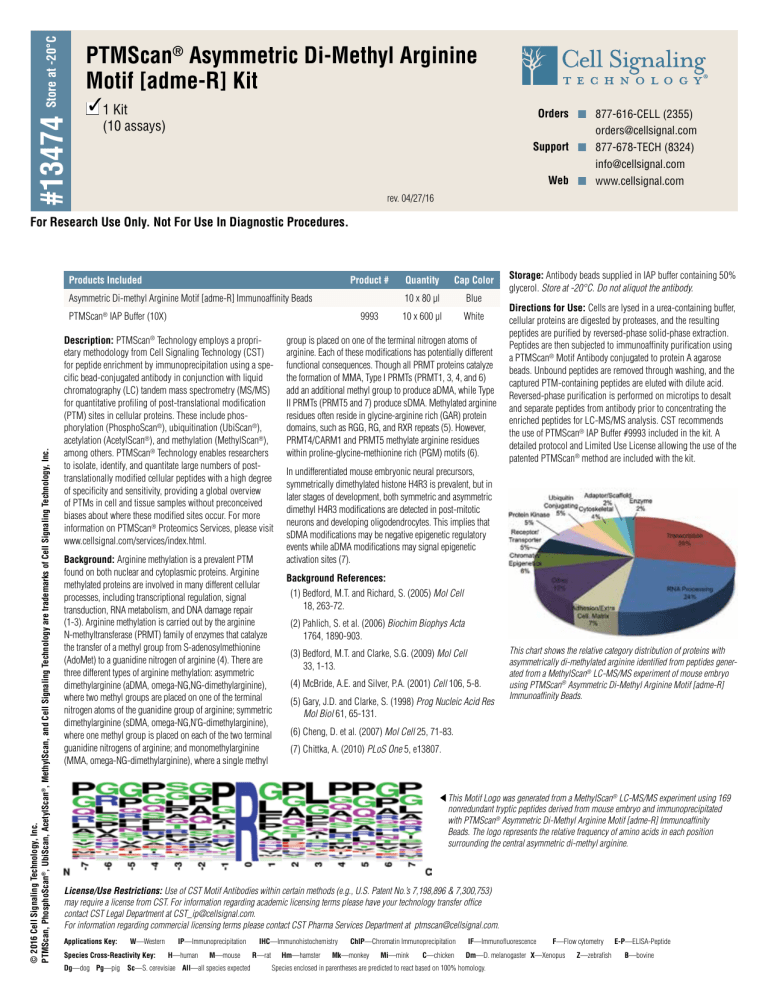
PTMScan
®
Asymmetric Di-Methyl Arginine
Motif [adme-R] Kit
3
1 Kit
(10 assays)
Orders
n
877-616-CELL (2355) orders@cellsignal.com
Support
n
877-678-TECH (8324) info@cellsignal.com
Web
n
www.cellsignal.com
rev. 04/27/16
For Research Use Only. Not For Use In Diagnostic Procedures.
Products Included
Asymmetric Di-methyl Arginine Motif [adme-R] Immunoaffinity Beads
PTMScan ® IAP Buffer (10X)
Product # Quantity Cap Color
10 x 80 μl Blue
9993 10 x 600 μl White
Description: PTMScan ® Technology employs a proprietary methodology from Cell Signaling Technology (CST) for peptide enrichment by immunoprecipitation using a specific bead-conjugated antibody in conjunction with liquid chromatography (LC) tandem mass spectrometry (MS/MS) for quantitative profiling of post-translational modification
(PTM) sites in cellular proteins. These include phosphorylation (PhosphoScan ® ), ubiquitination (UbiScan ® ), acetylation (AcetylScan ® ), and methylation (MethylScan ® ), among others. PTMScan ® Technology enables researchers to isolate, identify, and quantitate large numbers of posttranslationally modified cellular peptides with a high degree of specificity and sensitivity, providing a global overview of PTMs in cell and tissue samples without preconceived biases about where these modified sites occur. For more information on PTMScan ® Proteomics Services, please visit www.cellsignal.com/services/index.html.
Background: Arginine methylation is a prevalent PTM found on both nuclear and cytoplasmic proteins. Arginine methylated proteins are involved in many different cellular processes, including transcriptional regulation, signal transduction, RNA metabolism, and DNA damage repair
(1-3). Arginine methylation is carried out by the arginine
N-methyltransferase (PRMT) family of enzymes that catalyze the transfer of a methyl group from S-adenosylmethionine
(AdoMet) to a guanidine nitrogen of arginine (4). There are three different types of arginine methylation: asymmetric dimethylarginine (aDMA, omega-NG,NG-dimethylarginine), where two methyl groups are placed on one of the terminal nitrogen atoms of the guanidine group of arginine; symmetric dimethylarginine (sDMA, omega-NG,N’G-dimethylarginine), where one methyl group is placed on each of the two terminal guanidine nitrogens of arginine; and monomethylarginine
(MMA, omega-NG-dimethylarginine), where a single methyl group is placed on one of the terminal nitrogen atoms of arginine. Each of these modifications has potentially different functional consequences. Though all PRMT proteins catalyze the formation of MMA, Type I PRMTs (PRMT1, 3, 4, and 6) add an additional methyl group to produce aDMA, while Type
II PRMTs (PRMT5 and 7) produce sDMA. Methylated arginine residues often reside in glycine-arginine rich (GAR) protein domains, such as RGG, RG, and RXR repeats (5). However,
PRMT4/CARM1 and PRMT5 methylate arginine residues within proline-glycine-methionine rich (PGM) motifs (6).
In undifferentiated mouse embryonic neural precursors, symmetrically dimethylated histone H4R3 is prevalent, but in later stages of development, both symmetric and asymmetric dimethyl H4R3 modifications are detected in post-mitotic neurons and developing oligodendrocytes. This implies that sDMA modifications may be negative epigenetic regulatory events while aDMA modifications may signal epigenetic activation sites (7).
Background References:
(1) Bedford, M.T. and Richard, S. (2005) Mol Cell
18, 263-72.
(2) Pahlich, S. et al. (2006) Biochim Biophys Acta
1764, 1890-903.
(3) Bedford, M.T. and Clarke, S.G. (2009) Mol Cell
33, 1-13.
(4) McBride, A.E. and Silver, P.A. (2001) Cell 106, 5-8.
(5) Gary, J.D. and Clarke, S. (1998) Prog Nucleic Acid Res
Mol Biol 61, 65-131.
(6) Cheng, D. et al. (2007) Mol Cell 25, 71-83.
(7) Chittka, A. (2010) PLoS One 5, e13807.
Storage: Antibody beads supplied in IAP buffer containing 50% glycerol.
Store at -20°C. Do not aliquot the antibody.
Directions for Use: Cells are lysed in a urea-containing buffer, cellular proteins are digested by proteases, and the resulting peptides are purified by reversed-phase solid-phase extraction.
Peptides are then subjected to immunoaffinity purification using a PTMScan ® Motif Antibody conjugated to protein A agarose beads. Unbound peptides are removed through washing, and the captured PTM-containing peptides are eluted with dilute acid.
Reversed-phase purification is performed on microtips to desalt and separate peptides from antibody prior to concentrating the enriched peptides for LC-MS/MS analysis. CST recommends the use of PTMScan ® IAP Buffer #9993 included in the kit. A detailed protocol and Limited Use License allowing the use of the patented PTMScan ® method are included with the kit.
This chart shows the relative category distribution of proteins with asymmetrically di-methylated arginine identified from peptides generated from a MethylScan
Immunoaffinity Beads.
® LC-MS/MS experiment of mouse embryo using PTMScan ® Asymmetric Di-Methyl Arginine Motif [adme-R]
This Motif Logo was generated from a MethylScan ® LC-MS/MS experiment using 169 nonredundant tryptic peptides derived from mouse embryo and immunoprecipitated with PTMScan ® Asymmetric Di-Methyl Arginine Motif [adme-R] Immunoaffinity
Beads. The logo represents the relative frequency of amino acids in each position surrounding the central asymmetric di-methyl arginine.
License/Use Restrictions: Use of CST Motif Antibodies within certain methods (e.g., U.S. Patent No.’s 7,198,896 & 7,300,753) may require a license from CST. For information regarding academic licensing terms please have your technology transfer office contact CST Legal Department at CST_ip@cellsignal.com.
For information regarding commercial licensing terms please contact CST Pharma Services Department at ptmscan@cellsignal.com.
Applications Key: W —Western IP —Immunoprecipitation
Dg —dog Pg —pig Sc —S. cerevisiae All —all species expected
IHC —Immunohistochemistry ChIP —Chromatin Immunoprecipitation
Species Cross-Reactivity Key: H —human M —mouse R —rat Hm —hamster Mk —monkey Mi —mink C —chicken
IF
Dm
—Immunofluorescence
—D. melanogaster
Species enclosed in parentheses are predicted to react based on 100% homology.
X
F —Flow cytometry E-P —ELISA-Peptide
—Xenopus Z —zebrafish B —bovine
PTMScan
®
Kit Protocol
A. Solutions and Reagents
Reagents Not Included:
1.
HEPES (Sigma, H-4034)
2.
Sodium pyrophosphate (Sigma, S-6422)
3.
β -glycerophosphate (Sigma, G-9891)
4.
Urea, Sequanal grade (Thermo Scientific, 29700)
5.
Sodium orthovanadate (Sigma, S-6508)
6.
Iodoacetamide (Sigma, I-6125)
7.
Dithiothreitol (DTT) (Cell Signaling Technology, 7016)
8.
Trypsin-TPCK (Worthington, LS-003744)
9.
Trypsin (Promega, V5113)
10.
Lysyl Endopeptidase, LysC (Wako, 129-02541)
11.
Trifluoroacetic acid (TFA), Sequanal grade
(Thermo Scientific, 28903)
12.
Trifluoroacetic Acid (TFA), Reagent grade
(American Bioanalytical, AB02010)
13.
Acetonitrile (Thermo Scientific, 51101)
14.
Sep-Pak ® Classic C18 columns, 0.7 ml
(Waters, WAT051910)
15.
Burdick and Jackson Water (Honeywell, AH365-4)
16.
1x Phosphate-buffered saline (PBS)
(Cell Signaling Technology, 9808)
17.
HEPES (Sigma, H-4034)
18.
1 mM Hydrochloric acid (HCL)
19.
Ammonium bicarbonate (Sigma, A-6141)
NOTE: Prepare solutions for cell lysis (Section I), Sep-Pak purification (Section II), and IAP enrichment
(Section III) with reverse osmosis deionized (RODI) or equiva-lent grade water. Prepare solutions using
HPLC grade water (Burdick and Jackson water) for the peptide concentration steps (Section IV and V).
Stock Solutions:
1.
HEPES, pH 8.0 (200mM): Dissolve 23.8 g HEPES in approximately 450 ml water, adjust to pH 8.0 with 5 M NaOH, and bring to a final volume of 500 ml. Filter through a 0.22 µM filter. Store at 4°C for use up to six months.
2.
Sodium pyrophosphate: Make 50X stock (125 mM): 1.1 g/20 ml. Store at 4°C for up to six months.
3.
β -glycerophosphate: Make 1000X stock: 2.2 g/10 ml. Divide into 100 µl aliquots and store at -20°C.
4.
Sodium orthovanadate: Make 100X stock: 1.84 g/100 ml. Sodium orthovanadate must be depolymerized (activated) according to the following protocol: a. For a 100 ml solution, fill up with water to approximately 90 ml. Adjust the pH to 10.0 using 1 M
NaOH with stirring. At this pH, the solution will be yellow.
b. Boil the solution until it turns colorless and cool to room temperature (put on ice for cooling).
c. Readjust the pH to 10.0 and repeat step 2 until the solution remains colorless and the pH stabilizes at 10.0 (usually it takes two rounds). Adjust the final volume to 100 ml with water.
d. Store the activated sodium orthovanadate in 1 ml aliquots at -20°C for up to six months. Thaw one aliquot for each experiment; do not refreeze thawed vial.
5.
Dithiothreitol (DTT): Make 1.25 M stock: 19.25 g/100 ml. Divide into 200 µl aliquots. Store at -20°C for up to one year. Thaw one aliquot for each experiment.
6.
Trypsin-TPCK (Worthington): Store dry powder for up to 2 years at -80°C. Seal the cap of the trypsin-TPCK container with parafilm to avoid collecting moisture, which can lead to degradation of the reagent. Prepare 1 mg/ml stock in 1 mM HCl. Divide into 1 ml aliquots. Store at -80°C for up to one year.
7.
Lysyl Endopeptidase (LysC): Store dry powder up to 2 years at -80°C. Seal the cap of the LysC container with parafilm to avoid collecting moisture, which can lead to degradation of the reagent. Prepare 5 mg/ml stock in 20 mM HEPES pH 8.0. Divide into single use aliquots, store at -80°C for up to one year.
I. Cell Lysis and Protein Digestion
A. Solutions and Reagents
NOTE: Prepare solutions with RODI or equivalent grade water.
1.
Urea Lysis Buffer: 20 mM HEPES pH 8.0, 9 M urea, 1 mM sodium orthovanadate, 2.5 mM sodium pyrophosphate, 1 mM β -glycerophosphate.
NOTE: The Urea Lysis Buffer should be prepared fresh prior to each experiment. Do not include protease inhibitors.
NOTE: Dissolving urea is an endothermic reaction. Urea Lysis Buffer preparation can be facilitated by placing a stir bar in the beaker and by using a warm (not hot) water bath on a stir plate. 9 M urea is used so that upon lysis, the final concentration is approximately 8 M. The urea lysis buffer should be used at room temperature. Placing the urea lysis buffer on ice will cause the urea to precipitate out of solution.
2.
DTT solution (1.25 M) (see stock solutions for preparation)
3.
Iodoacetamide solution: Dissolve 95 mg of iodoacetamide in water to a final volume of 5 ml. After weighing the powder, store in the dark and add water only immediately before use. The iodoacetamide solution should be prepared fresh prior to each experiment.
B. Preparation of Cell Lysate, Suspension Cells
1.
Grow approximately 1-2 x 10 8 cells for each experimental condition (enough cells to produce approximately 10-20 mg of soluble protein).
2.
Harvest cells by centrifugation at 130 x g, for 5 min at room temperature. Carefully remove supernatant, wash cells with 20 ml of cold 1x PBS, centrifuge, remove PBS wash, and add 10 ml Urea Lysis
Buffer (room temperature) to the cell pellet. Pipet the slurry up and down a few times (do not cool lysate on ice as this may cause precipitation of the urea).
NOTE: If desired, the PTMScan ® protocol may be interrupted at this stage. The harvested cells can be frozen and stored at -80°C for several weeks.
3.
Using a microtip, sonicate lysate at 15 W output with 3 bursts of 15 sec each. Cool on ice for 1 min between each burst. Clear the lysate by centrifugation at 20,000 x g for 15 min at room temperature and transfer the protein extract (supernatant) into a new tube.
NOTE: Centrifugation is performed at room temperature to prevent urea from precipitating out of solution.
NOTE: Lysate sonication fragments DNA and reduces sample viscosity. Ensure that the sonicator tip is submerged in the lysate. If the sonicator tip is not submerged properly, it may induce foaming and degradation of your sample.
C. Peparation of Cell Lysate, Adherent Cells
1.
Grow 1-2 x 10 8 cells for each experimental condition (enough cells to produce approximately 10-20 mg of soluble protein). The cell number corresponds to approximately 10 x 150 mm culture dishes (depending on the cell type), grown to 70-80% confluence.
2.
Harvest all 10 x 150 mm culture dishes for one sample, remove media from the first dish by decanting, and let stand in a tilted position for 30 seconds so the remaining medium flows to the bottom edge. Remove the remainder of the medium at the bottom edge with a P-1000 micropipettor. Rinse each dish with 5 ml of cold PBS. Remove PBS as described above.
3.
Add 10 ml of Urea Lysis Buffer (at room temperature) to the first dish, scrape the cells into the buffer, and let the dish stand in tilted position after scraping the buffer to the bottom edge of the tilted dish. Remove the medium from the second dish as above. Transfer the lysis buffer from the first dish to the second dish using a 10 ml pipette, then tilt the first dish with the lid on for 30 sec and remove remaining buffer from the dish and collect. Scrape cells from the second dish and repeat the process until the cells from all the dishes have been scraped into the lysis buffer. Collect all lysate in a 50 ml conical tube.
NOTE: DO NOT place Urea Lysis Buffer or culture dishes on ice during harvesting. Harvest cells using Urea
Lysis Buffer at room temperature. During lysis, the buffer becomes viscous due to DNA released from the cells.
4.
The yield will be approximately 9-12 ml lysate after harvesting all the culture plates.
5.
NOTE: If desired, the PTMScan ® protocol may be interrupted at this stage. The cell lysate can be frozen and stored at -80°C for several weeks.
Using a microtip, sonicate lysate at 15 W output with 3 bursts of 15 sec each. Cool on ice for 1 min between each burst. Clear the lysate by centrifugation at 20,000 x g for 15 min at room temperature and transfer the protein extract (supernatant) into a new tube.
NOTE: Lysate sonication fragments DNA and reduces sample viscosity. Ensure that the sonicator tip is submerged in the lysate. If the sonicator tip is not submerged properly, it may induce foaming and degradation of your sample.
D. Reduction and Alkylation of Proteins
1.
Add 1/278 volume of 1.25 M DTT to the cleared cell supernatant (e.g. 36 µl of 1.25 M DTT for 10 ml of protein extract), mix well and place the tube into a 55ºC incubator for 30 min.
2.
Cool the solution on ice briefly until it has reached room temperature.
3.
Add 1/10 volume of iodoacetamide solution to the cleared cell supernatant, mix well, and incubate for
15 min at room temperature in the dark.
E. Protease Digestion
1.
Dilute 4-fold with 20 mM HEPES pH 8.0 to a final concentration of approximately 2 M urea, 20 mM
HEPES, pH 8.0. For example, add 30 ml 20 mM HEPES pH 8.0 for 10 ml of lysate.
* To view an updated protease digestion reference table, please visit http://www.
cellsignal.com/services/ptmscan_kits.html
NOTE: For LysC-digested material, a second protease digestion is required after the C18 tip purification of enriched peptides (see the protocol after C18 tip Purification). A secondary trypsin digest is also recommended for enriched methylated tryptic peptides.
NOTE: Alternative proteases such as GluC, chymotrypsin, and others can be used in addition to the protease treatments outlined in the reference table to expand the coverage of modified peptides from each
Motif Antibody. When considering the use of additional protease treatments it should be compatible with the respective Motif Antibody by not cleaving residues within the designated sequence motif. Protease treatments that generate larger proteolytic peptides may not be ideal if the resulting peptides do not ionize well in the mass spectrometer.
F. Trypsin Digestion
1.
Add 1/100 volume of 1 mg/ml Trypsin-TPCK (Worthington, LS003744) stock in 1 mM HCl and digest overnight at room temperature with mixing.
2.
Analyze the lysate before and after digest by SDS-PAGE to check for complete digestion.
3.
Continue through the Sep-Pak, IAP, and C18 tip protocols prior to LC-MS analysis of enriched peptides.
G. LysC Digestion
1.
Prepare 5 mg/ml stock solution of LysC in 20 mM HEPES pH 8.0. Aliquot for single use and store at -80°C.
2.
Add LysC solution to peptides at 1:250 (w:w). For 20 mg sample, use 20 mg ÷ 250 = 80 µg x 1 µl/5 µg =
16 µl LysC and digest overnight at room temperature.
3.
Analyze the lysate before and after digest by SDS-PAGE to check for complete digestion.
4.
Continue through the Sep-Pak, IAP, and C18 tip protocols before conducting the SECONDARY DIGES-
TION with trypsin (see end of protocol, Trypsin Digestion of Enriched LysC or Methylated Peptides).
Orders n 877-616-CELL (2355) orders@cellsignal.com Support n 877-678-TECH (8324) info@cellsignal.com Proteomic Services Department n ptmscan@cellsignal.com Web n www.cellsignal.com/proteomics
II. Sep-Pak
®
C
18
Purification of Lysate Peptides
NOTE: Purification of peptides is performed at room temperature on 0.7 ml Sep-Pak columns from
Waters Corporation, WAT051910.
NOTE: Sep-Pak ® C18 purification uses reversed-phase (hydrophobic) solid-phase extraction. Peptides and lipids bind to the chromatographic material. Large molecules such as DNA, RNA, and most protein, as well as hydrophilic molecules such as many small metabolites are separated from peptides using this technique. Peptides are eluted from the column with 40% acetonitrile (MeCN) and separated from lipids and proteins, which elute at approximately 60% MeCN and above.
NOTE: About 20 mg of protease-digested peptides can be purified from one Sep-Pak column. Purify peptides immediately after proteolytic digestion.
A. Solutions and Reagents
NOTE: Prepare solutions with RODI or equivalent grade water. Use Trifluoroacetic acid (TFA), Reagent grade (American Bioanalytical, AB02010) and Pierce™ Acetonitrile (ACN), LC-MS Grade (Thermo
Scientific, 51101) when preparing solutions. All percentage specifications for solutions are vol/vol.
1.
20% trifluoroacetic acid (TFA): add 10 ml TFA to water to a total volume of 50 ml.
2.
Solvent A (0.1% TFA): add 5 ml of 20% TFA to 995 ml water.
3.
Solvent B (0.1% TFA, 40% acetonitrile): add 400 ml of acetonitrile (MeCN) and 5 ml of 20% TFA to 500 ml of water, adjust final volume to 1 l with water.
3.
Wash buffer (0.1% TFA, 5% acetonitrile): For 100 ml of wash buffer, add 0.5 ml of 20% TFA to 50 ml of water, then add 5 ml of acetonitrile, adjust final volume to 100 ml with water.
NOTE: Organic solvents are volatile. Tubes containing small volumes of these solutions should be prepared immediately before use and should be kept capped as much as possible because the organic components evaporate quickly.
B. Acidification of Digested Cell Lysate
NOTE: Before loading the peptides from the digested sample on the column, they must be acidified with TFA for efficient peptide binding. The acidification step helps remove fatty acids from the digested peptide mixture.
1.
Add 1/20 volume of 20% TFA to the digest for a final concentration of 1% TFA. Check the pH by spotting a small amount of peptide sample on a pH strip (the pH should be under 3). After acidification, allow precipitate to form by letting sample stand for 15 min on ice.
2.
Centrifuge the acidified peptide solution for 15 min at 1,780 x g at room temperature to remove the precipitate. Transfer peptide-containing supernatant into a new 50 ml conical tube without dislodging the precipitated material.
C. Peptide Purification
NOTE: Application of all solutions should be performed by gravity flow.
1.
Connect a 10 cc syringe (remove plunger) to the SHORT END of the Sep-Pak column.
2.
Pre-wet the column with 5 ml 100% MeCN.
NOTE: Each time solution is applied to the column, air bubbles form in the junction where the 10 cc syringe meets the narrow inlet of the column. These must be removed with a gel-loading tip placed on a
P-200 micropipettor, otherwise the solution will not flow through the column efficiently. Always check for appropriate flow.
3.
Wash sequentially with 1 ml, 3 ml, and 6 ml of Solvent A (0.1% TFA).
4.
Load acidified and cleared digest (from Section B ).
NOTE: In rare cases, if the flow rates decrease dramatically upon (or after) loading of sample, the purification procedure can be accelerated by gently applying pressure to the column using the 10 cc plunger after cleaning it with organic solvent. Again make sure to remove air bubbles from the narrow inlet of the column before doing so. Do not apply vacuum.
5.
Wash sequentially with 1 ml, 5 ml, and 6 ml of Solvent A (0.1% TFA).
6.
Wash with 2 ml of wash buffer.
7.
Place columns above new 15 or 50 ml polypropylene tubes to collect eluate. Elute peptides with a sequential wash of 3 x 2 ml of Solvent B (0.1% TFA, 40% acetonitrile).
8.
Freeze the eluate on dry ice (or -80°C freezer) for 2 hr to overnight and lyophilize frozen peptide solution for a minimum of 2 days to assure TFA has been removed from the peptide sample.
NOTE: The lyophilization should be performed in a standard lyophilization apparatus. DO NOT USE a
SPEED-VAC apparatus at this stage of the protocol.
NOTE: The lysate digest may have a much higher volume than the 10 cc reservoir will hold (up to
50-60 ml from adherent cells) and therefore the peptides must be applied in several fractions. If available, a 60 cc syringe may be used in place of a 10 cc syringe to allow all sample to be loaded into the syringe at once.
4.
NOTE: Lyophilized, digested peptides are stable at -80°C for several months (seal the closed tube with parafilm for storage). The PTMScan ® procedure can be interrupted before or after lyophilization. Once the lyophilized peptide is dissolved in IAP buffer (see next step), continue to the end of the procedure.
III. Immunoaffinity Purification (IAP)
A. Solutions and Reagents
NOTE: Prepare solutions with RODI or equivalent grade water. Trifluoroacetic acid should be of the highest grade. All percentage specifications for solutions are vol/vol.
1.
Materials Provided in the PTMScan Kit: 10X IAP buffer; dilute with RODI or equivalent water to
1X concentration before use. Store 1X buffer up to one month at 4°C.
B. Procedure
1.
Centrifuge the tube containing lyophilized peptide for 5 minutes at 2,000 x g at room temperature to collect all material for dilution in IAP buffer. Add 1.4 ml IAP buffer. Resuspend pellets mechanically by pipetting repeatedly with a P-1000 micropipettor taking care not to introduce excessive bubbles into the solution. Transfer solution to a 1.7 ml Eppendorf tube.
NOTE: After dissolving the peptide, check the pH of the peptide solution by spotting a small volume on pH indicator paper (The pH should be close to neutral, or no lower than 6.0. In the rare case that the pH is more acidic (due to insufficient removal of TFA from the peptide under sub-optimal conditions of lyophilization), titrate the peptide solution with 1 M Tris base solution that has not been adjusted for pH.
5-10 µl is usually sufficient to neutralize the solution.
2.
Clear solution by centrifugation for 5 min at 10,000 x g at 4°C in a microcentrifuge. The insoluble pellet may appear considerable. This will not pose a problem since most of the peptide will be soluble. Cool on ice.
3.
Centrifuge the vial of antibody-bead slurry at 2,000 x g for 30 sec and remove all buffer from the beads. Wash antibody beads four times with 1 ml of 1X PBS. Centrifuge at 2,000 x g after each wash.
Resuspend beads in 40 µl PBS in the provided vial.
4.
Transfer the peptide solution into the vial containing motif antibody beads. Pipet sample directly on top of the beads at the bottom of the tube to ensure immediate mixing. Avoid creating bubbles upon pipetting.
5.
Tighten the cap on the vial. Seal the top of the vial with parafilm to avoid leakage. Incubate on a rotator for 2 hr at 4°C.
6.
Centrifuge at 2,000 x g for 30 sec and transfer the supernatant with a P-1000 micropipettor to a labeled
Eppendorf tube to save at -80°C for future use. Flow-through material can be used for subsequent IAPs.
NOTE: Some Phenol Red pH indicator may remain (it co-elutes during the Sep-Pak ® C18 purification of peptides) and color the peptide solution yellow. This coloration has no effect on the immunoaffinity purification step.
NOTE: Perform all subsequent wash steps at 2-4°C. For all the washes except the final wash, avoid removing the last few microliters, since this may cause inadvertent removal of the beads.
7.
Add 1 ml of IAP buffer to the beads, mix by inverting tube 5 times, centrifuge for 30 sec at 2,000 x g, and remove supernatant with a P-1000 micropipettor.
8.
Repeat step 7 once for a total of TWO IAP buffer washes.
NOTE: All steps from this point forward should be performed with solutions prepared with Burdick and
Jackson or other HPLC grade water.
9.
Add 1 ml chilled HPLC water to the beads, mix by inverting tube 5 times, centrifuge for 30 sec at
2,000 x g, and remove supernatant with a P-1000 micropipettor.
10.
Repeat step 9 two times for a total of THREE water washes. During the last water wash, the tube may need to be shaken while inverting in order to ensure efficient mixing.
NOTE: After the last wash step, remove supernatant with a P-1000 micropipettor as before, then centrifuge for 5 sec at 2,000 x g to remove fluid from the tube walls, and carefully remove all remaining supernatant with a gel loading tip attached to a P-200 micropipettor.
11.
Add 55 µl of 0.15% TFA to the beads, tap the bottom of the tube several times (do not vortex), and let stand at room temperature for 10 min, mixing gently every 2-3 min.
NOTE: In this step, the post-translationally modified peptides of interest will be in the eluent.
12.
Centrifuge 30 sec at 2,000 x g in a microcentrifuge and transfer supernatant to a new 1.7 ml Eppendorf tube.
13.
Add 50 µl of 0.15% TFA to the beads, and repeat the centrifugation/elution step. Combine both eluents in the same 1.7 ml tube. Briefly centrifuge the eluent to pellet any remaining beads and carefully transfer eluent to a new 1.7 ml tube taking care not to transfer any beads.
IV. Concentration and Purification of Peptides for
LC-MS Analysis
NOTE: We recognize there are many other routine methods for concentrating peptides using commercial products such as ZipTip ® and C18 tips (see below) that have been optimized for peptide desalting/ concentration. Regardless of the particular method, we recommend that the method of choice be optimized for recovery and be amenable for peptide loading capacities of at least 10 µg.
C18 tips: Thermo Scientific, part number SP201
ZipTip ® : EMD Millipore, catalog number ZTC18S960
Orders n 877-616-CELL (2355) orders@cellsignal.com Support n 877-678-TECH (8324) info@cellsignal.com Proteomic Services Department n ptmscan@cellsignal.com Web n www.cellsignal.com/proteomics
V. Concentration and Purification of Peptides for LC-MS on StageTip
A. Solutions and Reagents
NOTE: Prepare solutions with Burdick and Jackson water or other HPLC grade water. Organic solvents
(trifluoroacetic acid, acetonitrile) should be of the highest grade. Pierce™ Trifluoroacetic Acid (TFA),
Sequencing grade (Thermo Scientific, 28903) and Pierce™ Acetonitrile (ACN), LC-MS Grade (Thermo
Scientific, 51101) are recommended.
1.
Solvent C (0.1% trifluoroacetic acid, 50% acetonitrile): add 0.1 ml trifluoroacetic acid to 40 ml HPLC water, then add 50 ml acetonitrile, adjust the final volume to 100 ml with HPLC water.
2.
Solvent D (0.1% trifluoroacetic acid): add 0.1 ml trifluoroacetic acid to 50 ml HPLC water, adjust the final volume to 100 ml with HPLC water.
3.
Solvent E (0.1% trifluoroacetic acid, 40% acetonitrile): add 0.1 ml trifluoroacetic acid to 30 ml HPLC water, then add 40 ml acetonitrile, adjust the final volume to 100 ml with HPLC water.
NOTE: Organic solvents are volatile. Tubes containing small volumes of these solutions should be prepared immediately before use and should be kept capped as much as possible, because the organic components evaporate quickly.
B. Procedure
1.
Equilibrate the C18 tip by passing 50 µl of Solvent C through (once) followed by 50 µl of Solvent D two times.
2.
Load sample by passing IP eluent through the C18 tip. Load IAP eluent in two steps using 50 µl in each step.
3.
Wash the C18 tip by passing 55 µl of Solvent D through two times.
4.
Elute peptides off the C18 tip by passing 10 µl of Solvent E through two times. Pool the resulting eluent.
5.
Dry down the C18 tip eluent in a vacuum concentrator (Speed-Vac). If a SECONDARY DIGESTION with trypsin is being performed, proceed with the trypsin digestion protocol below. Otherwise, redissolve the peptides in 50 µl of solvent D and repeat C18 tip purification (steps 1–4). A second C18 tip purification will remove any remaining antibody from the final peptide sample.
6.
Dry down the C18 tip eluent from the second C18 tip purification in a vacuum concen-trator (Speed-Vac) and redissolve the peptides in an appropriate solvent for LC-MS analysis such as 5% acetonitrile, 0.1% TFA.
VI. Trypsin Digestion of Enriched LysC or Methylated Peptides
NOTE: Trypsin digestion of enriched LysC or methylated tryptic peptides is recommended for all basophilic and methylation-specific motif antibodies.
1.
Prepare fresh 1 M ammonium bicarbonate stock solution.
2.
Prepare digestion buffer, 50 mM ammonium bicarbonate containing 5% acetonitrile.
3.
Dilute a stock solution of sequencing grade trypsin (Promega) with digestion buffer from 0.4 µg/µl to a final concentration of 25 ng/µl.
4.
Resuspend the dried, LysC digested or tryptic methylated peptides generated from the C18 tip concentration protocol above with 10 µl of trypsin solution (25 ng/µl, 250 ng total). Vortex 3 times to redissolve the peptides and microfuge the sample to collect peptides/trypsin solution at the bottom of the microfuge tube as the final step.
5.
Incubate the solution at 37°C for 2 hr.
6.
After trypsin digestion, add 1 µl of 5% TFA to the digest solution. Vortex to mix and briefly centrifuge to collect peptide solution at the bottom of the microfuge tube.
7.
Transfer the acidified peptide solution to a newly conditioned C18 tip, rinse the 0.5 ml Eppendorf tube once with 40 µl of 0.1% TFA, and apply the rinse solution to the C18 tip.
8.
Perform the C18 tip desalting of the peptide digest and elute the peptides into an Eppendorf tube, HPLC autosampler vial insert, or 96-well plate. Dry purified peptides under vacuum prior to LC-MS analysis
(as described above).
Use of these protocols is subject to the terms of a Limited Use License granted to Purchaser of a PTMScan ® Motif Antibody Kit (http://www.cellsignal.com/common/content/content.jsp?id=license-motif-kit). These protocols are provided under that limited license in conjunction with the sale of any PTMScan ® Motif Antibody Kits and may be protected by one or more of the following patents: U.S. Patent Nos. 7,198,896 and
7,300,753; U.S. Patent Publication No. 2014/0094594; and foreign equivalents, owned by CST.
Licenses are not assignable or transferable, in whole or in part, without the express written consent of CST. If you have obtained these protocols without the grant of a Limited Use License from CST, please contact ptmscan @ cellsignal.com to inquire about the terms of the required license.
Orders n 877-616-CELL (2355) orders@cellsignal.com Support n 877-678-TECH (8324) info@cellsignal.com Proteomic Services Department n ptmscan@cellsignal.com Web n www.cellsignal.com/proteomics
PTMScan
®
IAP Buffer (10X)
0.6 ml
Support:
+1-978-867-2388 (U.S.) www.cellsignal.com/support
Orders: 877-616-2355 (U.S.) orders@cellsignal.com
rev. 03/19/15
For Research Use Only. Not For Use In Diagnostic Procedures.
Description: PTMScan ® IAP Buffer is used to reconstitute lyophilized peptides prior to immunoaffinity purification (IAP).
Directions for Use: Thaw 10X PTMScan ® IAP buffer at room temperature or at 37 ºC. Ensure all contents are dissolved as some components may have precipitated upon freezing. If necessary, dissolve by shaking gently. Before use, dilute with Milli-Q or equivalenly purified H
2
O to 1X buffer (e.g., pipet 0.5 ml 10X
IAP buffer from the vial into 4.5 ml H
2
O).
Solutions and Reagents: 1X Buffer Components:
50 mM MOPS/NaOH pH 7.2
10 mM Na
2
HPO
4
50 mM NaCl
Storage: Store at -20ºC. Prepared 1X IAP Buffer can be stored up to one month at 4ºC.
Thank you for your recent purchase. If you would like to provide a review visit www.cellsignal.com/comments.
www.cellsignal.com
© 2015 Cell Signaling Technology, Inc.
PTMScan, AcetylScan, PhosphoScan, UbiScan, and Cell Signaling Technology are trademarks of Cell Signaling Technology, Inc.
Applications: W —Western IP —Immunoprecipitation IHC —Immunohistochemistry ChIP —Chromatin Immunoprecipitation IF —Immunofluorescence F —Flow cytometry E-P —ELISA-Peptide Species Cross-Reactivity: H —human M —mouse R —rat Hm —hamster
Mk —monkey Mi —mink C —chicken Dm —D. melanogaster X —Xenopus Z —zebrafish B —bovine Dg —dog Pg —pig Sc —S. cerevisiae Ce —C. elegans Hr —Horse All —all species expected Species enclosed in parentheses are predicted to react based on 100% homology.
